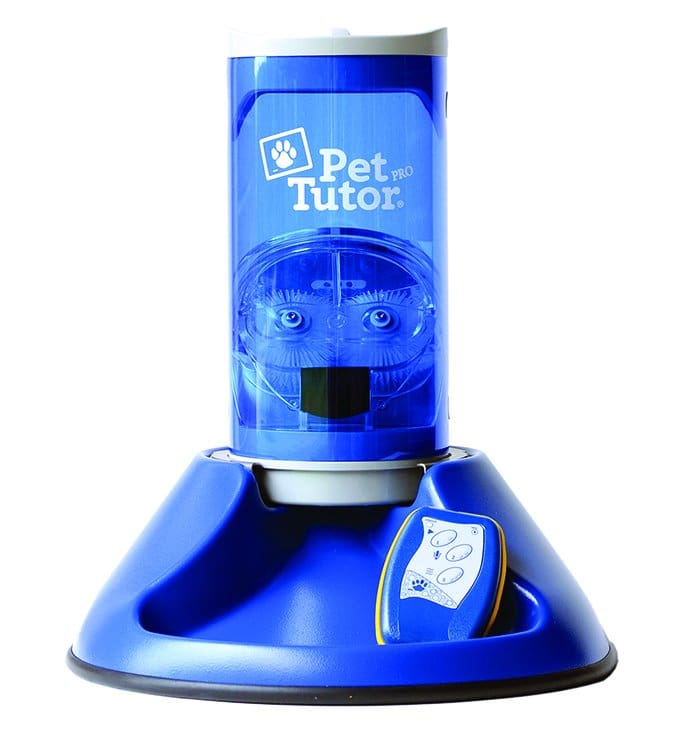My Border Collie Duncan solves all 10 of his interactive puzzles within five minutes; it takes me longer than that to fill them with treats! So when CleverPet announced its Kickstarter campaign for the development of a next-generation pet-learning console, I signed right up. Thirteen-year-old Duncan has pretty severe arthritis so I’m constantly searching for low-activity ways to engage him. This eagerly anticipated device features three durable yet sensitive touch pads that interactively light up and are designed to be touched by a dog’s nose or paw, triggering food to be dispensed. CleverPet adjusts learning levels based on your dog’s performance, which can be monitored through the website and an app-based program.
CleverPet, along with several other dog-related device makers and four speakers presenting on the intersection of animals and technology, were featured at the first-ever Pet Technology Conference, hosted by Smart Animal Training Systems and held at the Humane Society of Silicon Valley in Milpitas, California, in early November of last year. From the first speaker, I had a blast learning about the wide range of ways that dog lovers and scientists are using technological innovations to advance our understanding of and cooperation with dogs.

Tech in Client Training
Ethologist, trainer, and behaviorist Jennifer Cattet started off the first day’s discussions with a look at how technology can help dog trainers help their clients learn. Cattet emphasized that dog training is at heart a “people” job; she emphasized that trainers need to be aware that clients arrive with their own value systems and preconceptions, are emotionally involved and concerned with their pets, may react emotionally and become defensive when their beliefs are challenged, tend to be task-oriented, and want fast results.
Cattet has found success in addressing these considerations with technology. She uses videotaping and apps such as the Coach’s Eye while clients work with their dogs, in order to allow clients to review the session and observe their dog and themselves, giving themselves a very different perspective of the training session. By engaging the client in this way, the teaching dynamic changes, the client becomes part of the solution, and technology enhances the relationship between the client and her dog.
Jean Donaldson, founder of The Academy for Dog Trainers, which was operated at the San Francisco SPCA for 10 years, was the next speaker and is another enthusiastic adopter of technology in education. Acknowledging that dog trainers have a high rate of burnout, she recently re-envisioned her dog-training Academy in the form of a two-year e-learning program; the new technology-based approach has expanded the scope and content of the course.
Now an on-line certificate program, The Academy for Dog Trainers has an expansive curriculum that includes the latest research in behavior and training taught through lectures, modules, practica, assignments, quizzes, exams, webinars, case mentoring, discussion, and support.
The course is implemented through Articulate, a hosted e-learning service that allows the creation of educational content and delivery, enabling students to self-pace lectures and interact with different platforms and programs. This is supplemented with the use of other technology such as videos, Moodle (an open-source education platform), Adobe Connect, Vimeo Pro, and extensive on-line archives. This format for education allows students from all over the world to participate and is proving to be a good fit for teaching trainers who, due to the very nature of the business, tend to work in isolation.
Tech for Treating Canine Separation Anxiety
The phrase “separation anxiety” strikes a chord of fear in every dog trainer I know. But when a good friend came to me recently about this very problem with her dog, I immediately knew who to refer her to: another speaker at the conference, Malena DeMartini, who discussed how technology has been a game-changer for treating SA. DeMartini works strictly through technology; in fact, she never meets with her clients in person. While DeMartini does miss the in-person connection, she firmly believes that the use of technology is integral to the treatment of SA.
DeMartini explained how her “intake” process begins with an initial consult via phone or Skype. She asks the same questions any trainer would during an in-person interview and reviews the dog’s symptoms and case specifics. In lieu of touring the client’s home (where the dog has been displaying SA), she has her clients take her on a virtual tour of the home via a smart device or laptop. This remote consult functions well, since the presence of a trainer can change the dynamics of the environment and result in an inaccurate assessment.
The training sessions are also conducted through smart devices, laptops, and cameras that not only allow DeMartini and her client to communicate in real-time, but also provide the ability to observe and study the dog’s behavior (DeMartini uses FaceTime, Skype, and Google Hangout). The use of multiple cameras allows her to guide clients through an absence protocol via phone or computer while observing the dog’s behavior in real time, and frequent observation allows for flexibility in treatment.
The technology removes much of the guesswork about what the dog is doing when alone, and because the viewing is done remotely, the dog is not aware of the trainer’s presence. Furthermore, technology has virtually eliminated so many of the client compliance issues of the past. DeMartini says the benefits of this approach include:
– More accurate assessments
– More convenient and thus more frequent reassessments
– More support for the client
– Potential savings to client because travel fees have been eliminated
– Increased client motivation due to the frequency of sessions and the resulting – coaching, encouragement, and cheerleading
Thanks to technology, DeMartini has created a protocol for SA treatment that has greater efficiency and success.
Tech That Improves Bonds
While all of the conference speakers shared their experiences of how humans can use technology to support working with or training dogs, Dr. David Roberts, professor of Computer Science at North Carolina State University, talked about improving the bond between people and dogs through the use of computer-mediated interaction. Inspired by a dream he had about developing some form of technology to put in between the dog and the human to help communication between the species to be more effective, he and his team members embarked on developing the Smart Harness (see the harness in this National Science Foundation video here: tinyurl.com/smartharness).
The team focused on developing a system that can help decode canine postures and body language and then interpret it in a form that humans can better understand. The platform, a harness that fits comfortably on the dog, contains a suite of technology with dual communication functions. The first allows humans to communicate with the dog through speakers and haptics (vibrating motors).
The second provides feedback to the handlers through the use of harness-mounted physiological sensors, which monitor the dog’s heart rate and body temperature and detect his posture and behavior, thus enabling handlers to assess the dog’s physical condition and characterize his emotional and mental states.
The Smart Harness can be customized depending on the specific application, such as adding environmental sensors for search and rescue applications that can detect environmental hazards such as gas leaks, as well as cameras and microphones for collecting additional data. The team is especially interested in addressing ways to mitigate stress in service dogs, particularly because working dogs are bred and trained not to display signs of stress and stress is one of the main reasons these dogs are often retired early.
Dr. Roberts is also involved with the Canine Instruction with Instrumented Gadgets Administering Rewards (CIIGAR) Lab at NCSU. Devoted to canine research, the lab staff use artificial intelligence, machine learning, human/computer interaction, cognitive neuroscience, social psychology, and behavioral psychology to help humans and dogs better understand each other.
Roberts admits that if there’s a dog around, he has a difficult time focusing on anything else; he credits the connection that he feels with his dog when training to be the biggest reason he’s doing this type of work. “It’s never going to replace the human interaction with our dogs, but what it can do is help us interact with them in new ways,” Roberts says.
Products Ready for Use Now
In between presentations, the conference attendees had the opportunity to view a few technology-based dog products.
iFetch
Ideal for the ball-obsessed dog, this automatic ball launcher designed for smaller dogs launched a ball across the conference room. With a little bit of training, a dog can learn how to play fetch with his robotic buddy as well as decide when and how long he wants to play. The company hinted that it’s working on a new model to accommodate larger balls so the big dogs can play, too. See goifetch.com or call (512) 219-3271 for more information.

Pet Tutor™
The symposium sponsor, Smart Animal Training Systems, demonstrated its Pet Tutor™ through live demonstrations and examples of remote dog training. The Pet Tutor is a smart multipurpose feeder that can be triggered via remote or programmed to feed automatically at set times. It quietly dispenses only one to a few pieces of kibble at a time, so eating takes longer and becomes a fun and engaging experience.
The device also offers new and unique ways to support behavior-modification protocols for issues such as barking and separation anxiety. See smartanimaltraining.com (the company does not list a phone contact).
Beyond the Conference
While this conference was the first of its kind, the use of technology in association with our canine companions is not all that new. My dog has been microchipped for 13 years. I use a lighted leash when we walk in the dark. My veterinary hospital offers the latest diagnostics and treatment equipment from MRIs to CT scans to ultrasounds to lasers to electrochemotherapy.
What is new are the ways in which we now apply technology to the way we work, train, play, live, and communicate with our canine companions. As a culture, we are obsessed with technology and with our dogs, so it is only fitting that we are drawn to a combination of the two. The abundance of ever-smaller components created for the smart-device industry has allowed technology-based pet-friendly devices to proliferate at an unbelievable rate.
The following are some of the other high-tech pet products or innovations I’ve been impressed by that are on the market or in development today.
Treat & Train®
Sophia Yin, DVM, a pioneer in the field of merging technology with dog training, introduced a product that is similar to the PetTutor mentioned above – 10 years ago! Dr. Yin’s product was called the Treat & Train Dog Training System. Dr. Yin sold the rights to market the product to Sharper Image, who changed the product’s name to the Manners Minder™ Remote Reward Training System; it has since reverted to the name Treat & Train and is available through drsophiayin.com.
AutoTrainer™
The category of automatic reward-based training devices also includes PetSafe’s AutoTrainer, developed by Dr. Ian Dunbar and Dr. John Watson. This training aid was created to help eliminate problem barking and help calm dogs when their owners are away. A base unit dispenses kibble or treats and records the dog’s bark history; a collar transmits the dog’s barks to the base unit. The AutoTrainer uses the method of shaping behavior to decrease barking by marking and rewarding the dog for increasingly longer periods of quiet. Behavior that gets rewarded tends to get repeated. See petsafe.net or call (866) 738-4379.
GoPro Fetch
Want to see things from your dog’s perspective? Try GoPro’s Fetch, a dog harness/camera mount featuring two mounting-location options and compatibility with all GoPro adventure cameras for capturing your dog’s eye view with a video recording. If you want your pet to become a photographer, look at one of the many pet camera collars that take still photographs at set intervals. See gopro.com or call (888) 600-4659.
iCPooch
You can turn to a number of devices to help you interact with your pet while you’re away. The concept for iCPooch, a device that allows pet owners to interact with their pets from anywhere, was developed by a 12-year-old girl in association with her 8th-grade school project to stay in touch with her Golden Retriever. iCPooch utilizes technology to enable remote communication (two-way video, with the tablet required, not provided) and treat dispensing (via tablet or smart phone). You can check in on your pet at any time from anywhere (that is, provided your pet is near the unit). See icpooch.com for more information.
PetziConnect
The PetziConnect enables you to audio chat with your pet (as far as that is possible) and provide treats via smart device. The device has its roots in a popular Indiegogo crowd-funding launch that saw the company raise 265 percent of its needed start-up cash; dog owners are eager to receive and start using these interactive devices. It has the added options to take video and photos of your pets. The PetziConnect requires connectivity directly into an outlet, so placement is not as flexible as some of the other devices. See petzila.com for more information.
No More Woof
To further explore communication with dogs, the Nordic Society for Invention and Discovery, a small Scandinavian research lab, announced their plans to develop No More Woof, a device with sensors that is placed on a dog’s head to pick up EEG signals from the dog’s brain and attempt to translate this activity into human language.
The device utilizes microtechnology, special brain-computer interface software, and EEG sensoring to translate thought-pattern recognition into message such as “I’m tired,” “I’m curious,” or “I’m excited.” On the surface, the product appears to be a technology-based way of supporting what many of us already understand our dogs to be telling us, but advanced development could prove interesting. It’s extremely complicated to understand the canine brain and thought processes, as recent brain-mapping research with dogs undergoing MRIs has shown.
Veterinary Technology
Technology abounds in the veterinary field.
Most of us are familiar with ultrasounds, CT scans, MRIs, and lasers. Many of us also know that dreadful period of waiting while biopsies come back from the pathology lab after a surgery. Because malignant cells are so difficult to see, researchers at the University of Missouri College of Veterinary Medicine are testing out “cancer goggles” that can help surgeons see the actual cancer cells during the actual time of an operation with the help of a contrasting agent.
Dr. Samuel Achilefu, director at the Optical Radiology Lab and a professor of biomedical engineering at Washington University is the head researcher for this new technology designed for humans and other animals. It is hoped that the use of the goggles will reduce follow-up surgeries as well as decrease some of the anxiety, suffering, and pain on the part of patients (and owners).
VacciCheck
A few years ago, the USDA-approved VacciCheck, a new technology that allows quick and easy titer testing for parvovirus, distemper, and infectious hepatitis using a small blood sample and a testing kit. Within 21 minutes, the test determines whether or not the dog has antibodies to these diseases (indicating the dog has been adequately immunized against the diseases); it also can indicate if the dog might be carrying the disease.
VacciCheck has great potential for use in veterinary offices to prevent over-vaccination; an owner can ask for a blood sample to be taken at the beginning of a wellness exam, and by the end, the results of the test can help the owner decide whether further vaccination is needed. In larger facilities such as shelters, this technology can be cost-prohibitive and time-consuming for use on a regular basis (most shelters find that vaccinating is less expensive and quicker). However, many shelters use VacciCheck when they have breakouts of one the diseases, to assist with isolation and preventing the spread of these highly contagious viruses. See vaccicheck.com for more information.
Zumby
Animal Oraletrics plans to introduce a truly innovative canine oral-health tool in the spring of 2015. The product, called Zumby, looks like a dog toy but emits micro-current technology (undetectable to the dog) that finds the bacteria in a dog’s mouth, above and below the gum line, and destroys the bacteria’s cell walls. The technology has been safely used in humans for more than a century.
Zumby is constructed using a super-durable, nontoxic, rubber-like material formulated to withstand strong biters surrounding the rechargeable battery/circuit board unit (which is encased in an even tougher material). Zumby is motion-activated and an LED light blinks when it is on; non-toxic conductive material delivers the micro-current treatment when activated by your dog’s saliva. Combating oral bacteria helps to prevent gum and dental disease and thereby contributes to overall health. See oralectrics.com for more information.
3-D Printed Prosthetics
Three-dimensional printing is revolutionizing the field of custom products, including those for dogs with special needs. Derby, a mixed-breed dog born without fully formed front legs, was recently transformed by 3-D printed prosthetics designed by his foster owner Tara Anderson. (To watch a video of this amazing transformation, see tinyurl.com/3DDerbylegs.) Anderson, along with her team at 3D Systems, developed a looping prosthetic that suited the high-energy dog; he took off running the first time they were put on him.
Gentle Guider
Because guide-dog harnesses can cause discomfort for dogs working long hours, James Langdon redesigned the guide-dog harness using a 3-D printer. The Gentle Guider is contoured to a dog’s body using a 3-D scanner and then fabricated with a 3-D printer; it is currently in development in collaboration with the Guide Dogs for the Blind Associationin the United Kingdom. The great benefit of 3-D printing is that highly customizable items can be created and produced for individual needs quickly and at affordable costs.
Academia and Education
The emerging discipline of animals and technology has inspired the creation of the Animal-Computer Interaction (ACI) Lab at the Centre for Research in Computing of the Open University, in Buckinghamshire, UK. Like the CIIGAR Lab, ACI was established to expand the boundaries of interaction design beyond the human species by exploring the interaction between animals and technology, designing technology to support animals in different contexts, and developing user-centered approaches to the design of technology intended for animals.
ACI’s collaborative canine projects with partners from academia, industry, and other organizations include smart kennels to improve the welfare of kenneled dogs, biosensing harnesses to monitor welfare of working and companion dogs, wearable systems to support medical-alert dogs, and canine interfaces to support expression of discrimination by cancer-detection dogs.
Impressively, ACI acknowledges the importance of user-centered (from the perspective of the animal) design for animals and strives to ensure that the design of animal-related technology is appropriately informed by the animals’ characteristics and requirements. Ideally, dogs will benefit significantly from the support of technology designed from a canine-centered perspective.
Looking Forward
When I was teaching dog-training classes, I would emphasize to my students that we owed it to our dogs to learn their language in addition teaching them ours. Much of this new technology can aid us in learning more about our companions, in becoming better communicators with our dogs, and ultimately, creating stronger relationships with them.
In an upcoming issue, I’ll discuss the wealth of new high-tech products that can help track and locate dogs (whether they go missing, or have been sent on a mission of some kind for their human companions), as well as products that can monitor their biometrics (including pulse, respiration, and temperature) – exciting stuff.
Barbara Dobbins, a former dog trainer, writes about dogs and studies canine ethology. She lives in the San Francisco Bay area with her Border Collie, Duncan.





